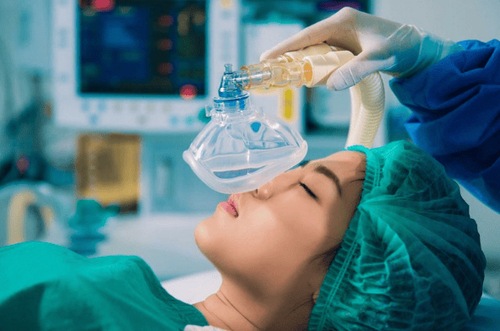This is an automatically translated article.
Posted by Master, Doctor CKII Nguyen Tat Binh - Department of Surgical Anesthesia - Vinmec Central Park International General Hospital
Similar to other specialties in medicine, in addition to providing the benefits of ensuring anesthesia for all types of surgery or procedures, interventions or procedures related to anesthesia also have some potential risks. Risks such as drug shock, anaphylaxis during anesthesia... The consequences of these hazards vary widely, from minor insignificant injuries to death.
1. Does the anesthesiologist need to explain the risks associated with anesthesia?
The risks associated with anesthesia that may affect the patient should be clearly explained by the anesthesiologist, usually during the pre-anesthetic evaluation. Doctors will use easy-to-understand terms to indicate the possibility of an anesthetic-related incident. Example: Sore throat symptoms will be explained by doctors as a very common undesirable effect in anesthesia, can be seen in 1-2 patients out of 10 patients (1:10) requiring general anesthesia. airway control device. Or doctors will also explain the rare risk of death if the risk is < 1:50,000.
| 1:10 | 1:100 | 1:1000 | 1:10.000 | 1:100.000 |
| Rất thường gặp | Thường gặp | Không thường gặp | Hiếm | Rất hiếm |
| Một vài người trong gia đình | Một vài người trên đường phố | Một vài người trong một làng | Một vài người trong một thị trấn nhỏ | Một vài người trong một thị trấn lớn |
In addition to the likelihood, the doctors will explain more about the severity of these events. Doctors will use words like very severe (severe), very vulnerable, tolerable... And finally, the patient will make (sign) a consent to anesthesia/ anesthesia / sedation when you have understood the benefits and risks that you may encounter.

Gây mê có thể gây ra đau họng
2. Common risks when performing sedation?
To make the patient comfortable and comfortable during certain diagnostic or therapeutic procedures, anesthesiologists may use sedation. With this method, depending on the level of sedation, the patient can be awake but comfortable with stimuli (awake sedation) to deep, painless sleep (deep sedation). And in all cases, cardiovascular or respiratory function will be self-maintained by the patient. Most patients wake up quickly after the procedure and stop the sedation. The most common side effects of this method are nausea, headache, or drowsiness. If encountered, the patient just needs to rest and monitor until the side effects of the anesthetic drugs are gone. In addition, a rare event was respiratory failure and cardiac arrest due to the patient's self-sustaining cardiovascular and respiratory function. Therefore, the anesthesiologist will always closely monitor the patient to promptly adjust the anesthetic and CPR when needed.
3. What are the risks associated with the neurosurgery technique?
Anesthesia is a technique that uses anesthetic drugs to block sensation and movement of a small area (local anesthesia) or a larger area (regional anesthesia) so that surgery can be performed. or tricks. With this method, the patient can stay awake during the surgery. Although this technique is very safe, there are certain risks and complications.
Some undesirable effects are very common such as drooping eyelids or double vision after anesthesia for eye surgery or common such as short-term nerve damage, urinary retention after regional anesthesia. Or other less common complications such as anesthetic poisoning, nerve damage after surgery (lasting more than 6 months). Rarer complications include anaphylaxis, epidural abscesses, permanent nerve damage, paralysis, or very rarely, postdural meningitis or epidural hematoma. In order to reduce these events, in addition to training the anesthesiologists skills, the application of technical means (eg ultrasound machine) also plays an important role.
4. Did the patient experience any complications during anesthesia?
General anesthesia (or often referred to as anesthesia for short) is a technique that uses drugs to induce sleep, analgesia and muscle relaxants to help patients sleep deeply, pain-free for surgery. Unlike sedation, usually the respiratory function will be completely controlled by the anesthesiologist by intubation and helping the patient to breathe.
Like other invasive techniques, general anesthesia also faces many different risks. The risks are very common such as sore throat, nausea and vomiting after surgery, headache, chills or common risks such as trauma to the mouth after intubation or difficult intubation. Uncommon risks such as aspiration pneumonia, cardiac arrest. Patients rarely lose vision, die from anesthesia. These risks can be greatly reduced if the pre-anesthesia evaluation is done well and the patient follows the instructions of the anesthesiologist.

Gây mê gây biến chứng viêm phổi hít nhưng rất hiếm gặp
Vinmec International General Hospital is one of the hospitals that strictly applies safe surgical anesthesia practice standards according to international guidelines. With a team of experienced anesthesiologists and nurses, along with modern equipment such as nerve detectors, ultrasound machines, Karl Storz difficult airway control system, anesthesia monitoring system GE's comprehensive AoA (Adequate of Anesthesia) including monitoring of anesthesia, pain and muscle relaxation will deliver high quality and safety, helping patients to have adequate anesthesia, not awake, no residual relaxant muscle after surgery. Vinmec Health System is also proud to be the first hospital in Vietnam to sign with the World Anesthesiology Association (WFSA) towards the goal of becoming the safest hospital for surgical anesthesia in Southeast Asia.
To protect heart health in general and detect early signs of myocardial infarction and stroke, customers can sign up for Cardiovascular Screening Package - Basic Cardiovascular Examination of Vinmec International General Hospital . The examination package helps to detect cardiovascular problems at the earliest through tests and modern imaging methods. The package is for all ages, genders and is especially essential for people with risk factors for cardiovascular disease.
Customers can directly go to Vinmec Health system nationwide to visit or contact the hotline here for support.
SEE MORE
Vinmec aims to be the safest hospital in Southeast Asia for surgical anesthesia The difference between anesthesia and anesthesia Learn about anesthesia, regional anesthesia














